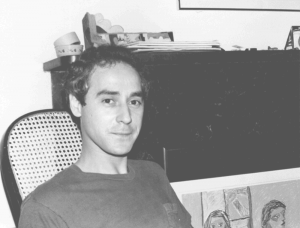Gabriel Capuano was born in Providence, RI on February 11, 1945, and died there on March 24, 1994, at the age of 49. He grew up on Smith Hill in Providence, a densely populated working-class neighborhood of first- and second-generation Americans of Irish, Polish, Armenian and Jewish descent.
After his father’s death, Capuano began demonstrating characteristics that would later identify him as an outsider. He regularly skipped school and was suspended before the age of sixteen. Although he was eventually identified as a gifted student by his teachers, he dropped out of school around this time and never went on to attend high school. He then spent most of his time on the streets earning money by selling newspapers late into night on an urban city corner, at bus and train stations and a local boxing arena. This exposed him to daytime and nocturnal imagery that would later appear in his paintings and drawings. In 1960 he started to have brushes with the law and at the age of seventeen he began experimenting with opiates.
In 1964, at nineteen years of age, Capuano was sentenced to two years in a maximum-security adult correctional institution in Rhode Island for drug-related activities. In the mid-1960s prisons in Rhode Island offered classes in art and literature as well as the more traditional educational programs. When Capuano’s talent became obvious, he was allowed to spend time painting and reading in his own single cell instead of a dormitory setting as protocol required, thus beginning a semi-monastic existence dedicated to painting, reading, and self-education.
Three professionals were involved in the prison arts program: Gene van Wye, art restorer and teacher; Sid Moore, artist and Rhode Island School of Design instructor; and Eugene Tonoff, artist and gallerist — all of whom realized Capuano showed an unusually strong talent for drawing and painting. Under their encouragement and influence Capuano became deeply committed to painting. He also began reading Shakespeare, Dostoevsky, Freud and Jung among other writers and thinkers.
Gene Tonoff, a well-established Providence personality whose gallery exhibited respected artists — generally Rhode Island School of Design professors and established graduates — created an exhibition of prisoners’ art, and The Providence Sunday Journal featured Capuano’s work on its cover. When he was released from prison in 1966, Capuano’s work was regularly included in Tonoff’s group exhibitions where it began to catch serious attention from Bradford Swan, a well-respected New England art critic.
In 1966, Capuano met Susan Diamond, a Providence high school teacher and in November 1967 they married. Diamond was instrumental in organizing Capuano’s exhibitions and promoting his work during his life and after his death.
The series of successful exhibits, new milieus and social contacts clashed with past experiences and created psychological strain for Capuano. He gradually resumed using substances such as marijuana and LSD until opiate drug addiction once more overcame him. He continued working sporadically throughout that period but ceased showing for almost a decade. He spent most of his life in conflict, dealing with substance addiction while constantly creating through it all.
Exhibitions
1967 Tonoff Gallery
Providence, Rhode Island – group show
“The best painting in the show, for me, was Gabriel Capuano’s haunting, strictly personalized vision, Through the Doorway”. (Bradford Swan, The Providence Sunday Journal)
1968 Tonoff Gallery
Providence, Rhode Island – group show:
“The small Capuano oil, Seated Figure, is one of the best things this painter has done. It’s amazing how he can cram into such a simple statement such a complexity of personal values.” (Bradford Swan, The Providence Sunday Journal)
1969 Wheeler Gallery
Providence, Rhode Island
“Capuano is still developing, and everything indicates he is going to go someplace. If he does, it is because he is a man who has lived and to compare him with painters who are playing at living is to make him seem richer and them poorer.” (Bradford Swan, The Providence Sunday Journal)
1972 Tonoff Gallery
Providence, Rhode Island
Two-person show
“Capuano’s drawing style has fascinated me for several years. Every now and then I think I see traces of Rembrandt’s ability and style in them.” (Bradford Swan, The Providence Sunday Journal)
1979 School One
Providence, Rhode Island
Solo show
“His pictures have more raw vitality … particularly in his small ink drawings he freezes tiny chips of experience that ring with verisimilitude” (Edward Sozanski, The Providence Sunday Journal)
1991 Modern Times Gallery
East Providence, Rhode Island
Solo show
“Capuano seems most at home using crayons … a medium rarely associated with serious art (but) perfectly suited to his nervous, expressionistic drawing style.” (Bill Van Siclen, The Providence Sunday Journal)
1992 Providence Preservation Society
Providence, Rhode Island
Pride and Perseverance: A Retrospective of Art in Rhode Island
Group show
1993 Ute Stebisch Gallery
Lenox, Massachusetts
Group show
Posthumous Retrospectives
1994, Providence City Hall Commemorative Exhibit
1994, Bert Gallery, Providence, Rhode Island, show of pen and ink works alongside “Providence Printmakers and Their Collections”
1995 The Gabriel Capuano Art Scholarship is established at Nathaniel Greene Middle School to be awarded to an older, struggling student showing significant artistic talent.
2005, DIG Fine Art, Providence, Rhode Island
2015, Gallery Z/Studio Z, Federal Hill, Providence, Rhode Island
2016-present, Anchor Inn Beach House, Provincetown, Massachusetts, ongoing rotating exhibition of house artist
Collections
Work in collections in London, England; Berlin, Germany; Los Angeles, California; New York City; Delaware; New Mexico; and other New England states
Educator
1968 -1970 he was a part-time art instructor at the prestigious Mary C. Wheeler School for Girls and helped create Wheeler Gallery. Capuano had been recommended for the position by a local art dealer and selected solely based on his art; other candidates were graduate painting students from Rhode Island School of Design.
1978-1980 Capuano taught at School One, where he had a solo exhibition.
Death
March 21, 1994, died suddenly, at home, at age forty-nine, of a probable heart attack. Gabriel Capuano is buried in Swan Point Cemetery, Providence, Rhode Island

